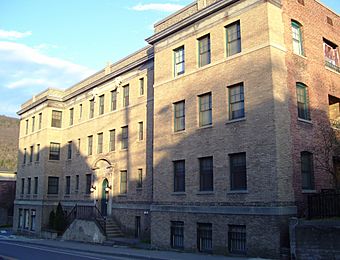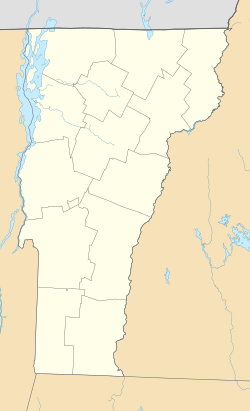Canal Street–Clark Street Neighborhood Historic District facts for kids
Quick facts for kids |
|
|
Canal Street–Clark Street Neighborhood Historic District
|
|

The Abbott
|
|
| Location | Roughly bounded by Canal, S. Main, Lawrence and Clark Sts., Brattleboro, Vermont |
|---|---|
| Area | 13.2 acres (5.3 ha) |
| Architectural style | Greek Revival, Queen Anne, Gothic Revival |
| NRHP reference No. | 93000593 |
| Added to NRHP | July 8, 1993 |
The Canal Street–Clark Street Neighborhood Historic District is a special area in Brattleboro, Vermont. It's like a time capsule of a neighborhood from the 1800s. Most of the buildings here are simple wooden homes. They were built between 1830 and 1935. You can also find a few apartment buildings and one church. This whole area was added to the National Register of Historic Places in 1993. This means it's an important place to protect because of its history.
Contents
Exploring the Historic Neighborhood
This historic area is located southwest of Brattleboro's main downtown. It sits on the south side of Canal Street, which is also United States Route 5. The neighborhood is surrounded by Canal Street to the north. South Main Street is to the east. To the south, you'll find the slopes of Prospect Hill.
Streets and Homes in the District
A small group of streets forms this neighborhood. These include Clark Street, Lawrence Street, and Estabrook Road. Most of the houses here are made of wood. They show simple versions of popular building styles from when they were built. There are also three buildings made of brick or stone. Only a few houses have fancy decorations. You'll also find a small number of buildings made specifically for multiple families to live in.
The First Universalist Church
The only building in the district that isn't a home is the First Universalist Church. It's located on Canal Street. This church was built between 1850 and 1851. It was designed in the Greek Revival style.
How the Neighborhood Grew
Brattleboro's main center was first settled in the 1700s. But it really started to grow a lot in the 1820s. This growth happened because of new ways to transport goods. First, people used the Connecticut River for boats. Then, the railroad arrived in 1849, making transport even easier.
Early Street Development
Canal Street was created sometime before 1845. It ran next to a canal along Whetstone Brook. This canal provided power for the town's factories. Some of the oldest houses in the district were built along the south side of Canal Street.
Clark Street's Purpose
Clark Street was laid out between 1845 and 1852. It runs mostly parallel to Canal Street. This street was named after Joseph Clark. He was an early landowner in the area. Clark Street was built to give access to the back of the long, narrow lots. This allowed the land to be divided into smaller pieces for more homes. Lawrence and Estabrook Streets were also built around this time.
Later Growth and The Abbott
By the late 1800s, most of the area had been built up. Then, a period of redevelopment began. More multi-family homes were built, mainly along the main roads. A large brick apartment building called The Abbott was built in 1911. It's located at the corner of Canal and South Main. It has many apartments and also shops on the ground floor.



